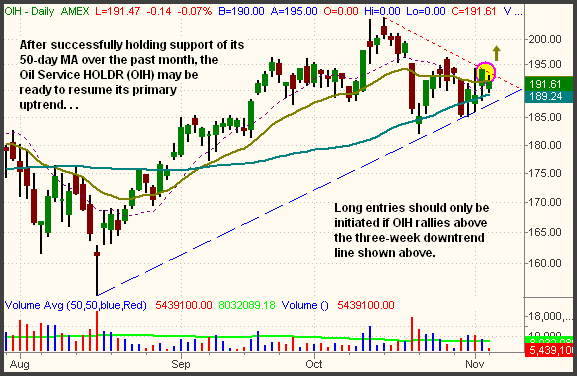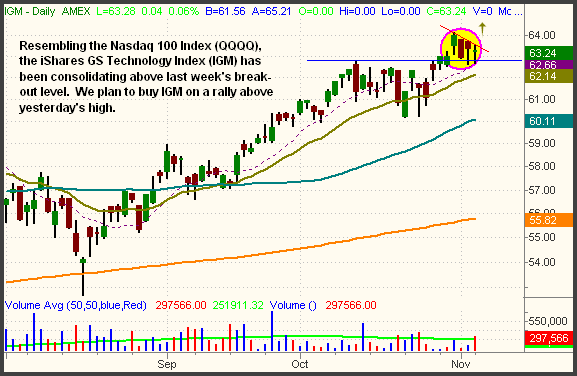| The Wagner Daily ETF Report for November 6 |
| By Deron Wagner |
Published
11/6/2007
|
Stocks
|
Unrated
|
|
|
|
The Wagner Daily ETF Report for November 6
More worrisome news out of the financial sector caused the broad market to open approximately 1% lower yesterday, but stocks quickly stabilized and held in a tight range throughout the morning. Selling pressure in the early afternoon briefly caused the major indices to dip to new intraday lows, but buyers arrived in the final hour and lifted stocks off their worst levels. Both the S&P 500 and Nasdaq Composite settled 0.5% lower, while the Dow Jones Industrial Average lost 0.4%. The small-cap Russell 2000 and S&P Midcap 400 indices were lower by 0.9% and 0.8% respectively. All of the main stock market indexes closed near the middle of their intraday ranges.
The one bright spot of yesterday's session is that the losses occurred on lower turnover. Total volume in the NYSE declined 10%, as volume in the Nasdaq registered 13% below the previous day's level. The lower volume losses in the S&P and Nasdaq prevented those indexes from registering another bearish "distribution day" that would have signaled the continued presence of institutional selling. Market internals were negative, but not by an overly wide margin. Declining volume in the Nasdaq exceeded advancing volume by a margin of approximately 2 to 1. The NYSE adv/dec volume ratio was negative by just over 3 to 1.
After holding intact through multiple tests of its 50-day MA support, the Oil Service HOLDR (OIH) may now be poised to break out above resistance of its three-week downtrend. Since mid-October, we have profited on the short side from two quick sell-offs in OIH, but its relative strength over the past week means its late October bearish sentiment may be reversing. A rally above the red dotted downtrend line shown on the daily chart below would trigger a buying opportunity in OIH. The blue dashed ascending line marks the lower boundary support of the primary ascending trend channel:

When the same chart shows both support of an uptrend line and resistance of a downtrend line, remember that the longer-term trendline wins out a majority of the time. However, because this setup is a resumption of a longer-term trend, it's important to wait for confirmation of the breakout above the three-week downtrend line before buying. Prematurely "jumping the gun" is dangerous because the failure of OIH to rally above the downtrend line could lead to a swift breakdown below the 50-day MA. Downward momentum would then quickly intensify as short sellers joined the party on the break of the weekly uptrend line. For maximum confirmation, consider waiting for a rally above the November 1 high of $194.26, as opposed to buying just over yesterday's high.
Last week, the iShares Goldman Sachs Technology Index Fund (IGM) broke out to a new all-time high. Since then, it has gently pulled back to successfully test support of its breakout level. This has led to a bullish consolidation on the hourly chart, right at support of the 10-day MA (the purple dotted line), a reliable indicator for entries in strong trends. A rally above yesterday's high would represent an ideal buy entry in IGM. The test of horizontal price support (the solid blue line) and consolidation at the highs (circled in pink) is illustrated on the following daily chart:

Although the S&P 500 and Nasdaq Composite both fell the same percentage yesterday, the overall technical picture did not change. As annotated yesterday, the S&P is still trying to hold above support of its October low and remains in danger of moving into a confirmed intermediate-term downtrend. Conversely, the Nasdaq continues to hold above the lower channel of its primary uptrend, as well as its 20-day EMA, and is consolidating near its six-year high. Because of this wide divergence, buying sectors with relative strength and/or selling short those with relative weakness is the only logical way to trade the current environment.
Computer Networking, Hardware, Software, and Internet sectors can be bought on pullbacks. Although not necessarily correlated to the Nasdaq, the Utilities, Oil Service, and the Medical Devices sectors are all showing relative strength as well. On the flip side, Banking, Securities Broker-Dealers, Insurance, and Retail sectors all present decent short sale opportunities on significant bounces into resistance. Maintaining a portfolio on both sides of the market makes sense until either the bulls or bears win the overall broad market tug-of-war.
Long - TWM, UNG
Short - (none, but TWM is a bearish position)
Deron Wagner is the Founder and Head Trader of both Morpheus Capital LP, a U.S. hedge fund, and Morpheus Trading Group, a trader education firm launched in 2001 that provides daily technical analysis of the leading ETFs and stocks. For a free trial to the full version of The Wagner Daily or to learn about Wagner's other services, visit MorpheusTrading.com or send an e-mail to deron@morpheustrading.com.
|